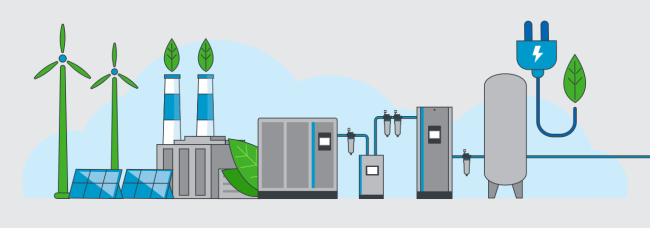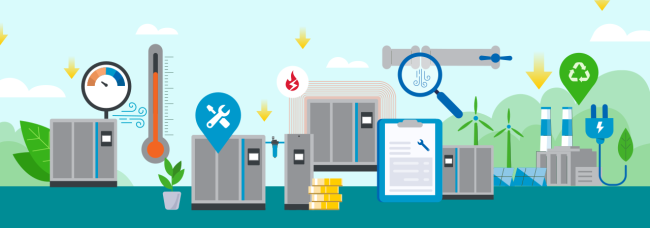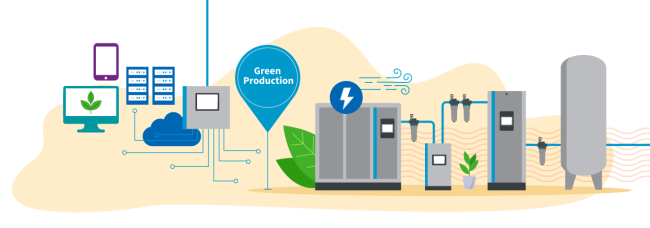5 minute read • published in partnership with Atlas Copco
Atlas Copco Compressors UK embarks on its Green Journey to support the Group’s climate ambitions
As a world leader in compressed air and industrial gas technology, Atlas Copco Compressors has embarked upon a Green Journey to support Atlas Copco Group’s global strategy to reduce greenhouse gas emissions from the entire value chain. This includes making further reductions in the energy consumed in its own operations, such as manufacturing sites, offices, and vehicles, as well as reducing emissions during the use of its products by supplying more energy-efficient solutions that enable customers to achieve major reductions in energy consumption and reduce carbon footprint within their own downstream applications. Oliver Kent, product marketing manager and chair of Atlas Copco’s Green Journey committee shares more.
The Green Journey
Rather than being directed only from top-down, the Green Journey initiative has been structured to include employees all across Atlas Copco Compressors UK who have volunteered to help define, shape and enact the company’s Green Journey. These employees are tasked with developing and promoting a range of activities and policies that the wider company can follow to reduce its carbon footprint. The initiatives must be lasting, with tangible benefits, and able to be woven seamlessly into the working life.
Right across the industrial landscape reliance on renewable sources of energy like wind or solar power alone is not enough to offset greenhouse gas emissions. Industry has to help in reducing the global energy demand and make more efficient use of the energy that it consumes. Atlas Copco can contribute to reducing industry’s electricity consumption by continuing to develop energy efficient products which are used by all industrial sectors.

Graphic: Atlas Copco
Science-Based targets
At current rates, greenhouse gas emissions are predicted to increase average global temperatures by 4–6°C by the end of this century, resulting in unmanageable climate change. To avoid this outcome more has to be done and at a much faster rate.
When a company sets Science-Based targets it is a commitment to ensure the company’s emissions are in line with the goals of the Paris Agreement on Climate Change reached in 2015 when 195 of the world’s governments pledged every effort to prevent the worst effects of climate change Setting high climate ambitions at a company level will help governments achieve their targets.
Science-based targets focus on greenhouse gas emissions reduction. They are based on the ‘carbon budget’ – the emissions permitted that will keep temperature increases within the limits set by the Paris Agreement. These endeavours work to limit the average global temperature increase to well below 2°C and pursue efforts to limit temperature increases to no more than 1.5°C above pre-industrial levels.
To give a true picture of their contribution, science-based targets are validated by the independent Science Based Targets initiative (SBTi) which assesses and approves companies’ targets in line with its strict performance criteria.

Graphic: Atlas Copco
Atlas Copco’s Science-Based targets
Fully committed to being part of the solution for a better tomorrow, the Atlas Copco Group has set itself science-based targets that will contribute towards achieving a low-carbon society. One of its approved science-based targets has been established that aims to reduce the emissions from the company’s direct operations by 46% by the year 2030, when compared to a 2019 baseline.
Another approved target is to reduce the carbon impact of products in use by 28% by the year 2030, when compared to the 2019 base level of emissions.
Finally, there are additional requirements to reduce water usage, achieve a 100% rate of waste recycling or re-use, and increase the number of sub-suppliers who operate with an approved Environmental Management System in place.
The main benefit of having such targets is that they inspire new ways of thinking, new initiatives and the actions needed for positive change. Atlas Copco’s Green Journey is one such initiative that demonstrates a conviction by both employees and management that it has the means to reduce its customers’ emissions.
The considerable number of companies that have committed to setting science-based targets shows a groundswell in climate ambition and brings with it more confidence about being on track to prevent the worst effects of climate change. There are clear benefits for businesses in setting science-based targets. To endorse that view, across industry, companies report that adopting a science-based target boosts profitability, improves investor confidence, drives innovation, reduces regulatory uncertainty, and strengthens brand reputation.

Graphic: Atlas Copco
Green applications
Atlas Copco challenges itself to develop and deliver even more energy-saving solutions for its customers and to apply its solutions within more ‘green applications’, as defined by the EU taxonomy. These applications facilitate the transition to a low-carbon society or help protect the environment. To be considered as green, they should contribute to the environmental objectives in the taxonomy, not adversely affect any of the environmental objectives and comply with minimum safeguards.
Some typical examples of a green application that might use Atlas Copco compressed air, industrial gas or process cooling products are the biogas industry that collects fuel gas from decaying organic matter; recycling plants that can repurpose waste material into a usable form; and companies that process hazardous materials. Some other production industries are also classed as green applications, such as electric vehicle and electric car battery manufacturers.
Energy-efficient solutions
In a production environment, going greener is all about energy efficiency. For example, conducting a non-intrusive energy audit to measure the efficiency of an existing compressed air installation, involving the use of a data logger such as Atlas Copco Compressors’ AIRchitect, is the best way to discover possible energy savings within an existing compressed air installation.
With energy making up to 40% of a company’s energy costs and up to 80% of a compressor system’s total cost of ownership, taking steps such as investing in energy-efficient compressor systems, as well as optimising existing systems to use significantly less energy, will see considerable reductions not only in the cost of running air compressors but in a production company’s carbon footprint.

Graphic: Atlas Copco
Most industrial compressed air applications experience a fluctuating air demand. By replacing a fixed-speed unit with a variable-speed drive (VSD) compressor that matches output to user demand will realise considerable energy savings overall. A VSD compressor will reliably deliver top-quality air while lowering energy consumption by an average of 50%.
Compressors generate heat that most businesses allow to dissipate as quickly as possible to keep the ambient temperature down. But instead of letting it go to waste, installing a heat recovery system, such as Atlas Copco Compressors’ ER control unit, between the compressor and the cooling- and heating circuits, will recover and re-use up to 90% of the energy required to run a compressor. The hot water, heated up to 90°C and recovered from the compressed air system, can be used for sanitary purposes and space heating but is particularly suitable for process water heating applications.
Future opportunities
The company’s drive towards the transformation to a low-carbon industrial landscape has revealed further opportunities to achieve emission controls. Looking to the future, Atlas Copco challenges itself to develop and deliver even more energy-saving solutions for its customers that will result in lower emissions from its products in use and contribute to climate ambitions.
